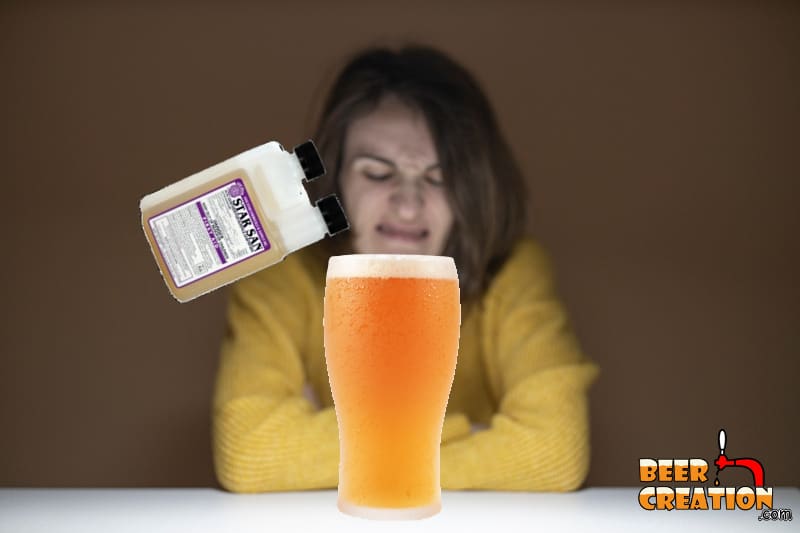For someone who has actually stopped drinking certain commercial brand beers because of what I heard was in them, the content of my beer matters to me.
So, using a no-rinse sanitizer like Star San on all my equipment did initially get me thinking, but after researching the topic I felt a lot better about the situation.
I guess you are here because you are also asking yourself whether or not using Star San will affect the taste of your finished beer.
If used in the suggested concentration, Star San is an effective no-rinse sanitizer, is safe to ingest, & has little impact on the taste of your beer. When the concentration (300 ppm) is exceeded, then you may start to notice a phenolic off-flavor that will present as bitterness or a medicinal note.
Before you rush off and brew your next batch, there is actually a little more to the story which I’d like to share with you, so be sure to read on!
What is Star San?

As you are reading this, I’m pretty sure you know, but just for those of you doing some research into homebrewing, let’s all start off on the same page.

Star San is a very popular sanitizer used in homebrewing to minimize the risk of bacterial infection in home-brewed beer. It’s most attractive quality is that Five Star, the manufacturer advertises that Star San is a no-rinse sanitizer, meaning that you don’t have to add an extra step to your brewing process.
If you are running low on Star San or haven’t bought this item before you can pick it up in most local homebrewing stores or even on Amazon (Check current prices and availability).
Is Star San safe to drink?
Yes, Star San is absolutely safe to drink when properly diluted but I definitely wouldn’t take a big gulp out of the bottle.
Star San is made up of phosphoric acid, alkylbenzene sulfonic acid, aliphatic dihydric alcohol, sulfuric acid and water. The former you get in your average soda, so it’s deemed very safe to drink, the latter ingredients, except water, of course, are fairly hazardous.
If you were to ingest any of these of the acids (and aliphatic dihydric alcohol) straight without them being diluted they would cause a lot of irritation to the skin and as it went down to your stomach. So why is it safe to use Star San as a no-rinse sanitizer?
The key thing is that when you are using Star San it should be diluted so that it’s only about 300 ppm when it comes in contact with you, your brewing equipment, and your beer. At this strength and at a lower ph level than 3, it’ll kill off any nasty bacteria and other microbes without, for want of a better phrase, killing you.
How does Star San work?
There are two answer here really, the first one is the layman’s response and the second one is what my doctorate friend would tell you. So I’ll try to do them both justice.
Basically, Star San is a solution that kills microorganisms, especially bacteria. Three of the five main ingredients in your Star San are antibacterial agents (phosphoric acid, alkylbenzene sulfonic acid, sulfuric acid).
On a molecular basis, the compounds within Star San can target bacteria (and other micro-organisms too as we’ll see later) due to physics.
Bacteria, especially the types which affect homebrewing are negatively charged whereas the compounds in Star San are largely positively charged. That ensures that they are attracted to each other, with the bacteria losing out in the exchange.
New to homebrewing? Please feel free to read my ultimate guide to brewing beer at home and where to start.
Does Star San kill yeast?
This is a tricky question to answer because the initial reaction is “no” it doesn’t because plenty of people brew beer successfully after having used Star San on equipment later used for fermentation.
However, if you ask the question “Can Star San kill yeast?” then the answer is “absolutely yes, it can”.
The thing, I believe, is that by the time Star San comes into contact with your yeast, especially in your fermenter, it’s at very low concentrations.
Although we use Star San in just 300 ppm when sanitizing equipment and that’s a very effective dilution to kill off any bacteria, the level of dilution is much higher when you add your wort.
The parts per million would rapidly reduce, and so the Star San becomes less effective (which is fine after it’s done its job) and less likely to kill yeast at this stage. In fact, Star San will just break down into sugar at this stage which the yeast can use as an additional nutrient.
(Shop for your brewing ingredients online at homebrewing.org).
Do you ever want Star San to kill off yeast?
According to the video by Beer on the Brain, it seems that using Star San to kill off yeast after you brew your beer is actually something you do want.
By sanitizing your brewing equipment after/before you brew, you can eliminate the risk of having unwanted yeast strains when brewing different varieties of beer.
Although using a no-rinse sanitizer is probably the best way to achieve this, you could also use a number of other techniques including boiling water.
How much Star San should you use?
It’s important to follow the directions of the manufacturer, especially if you want to reduce any chance that Star San will affect the taste of your finished beer. As I said before, Five Star, who makes Star San, recommends a concentration of 300 ppm.
So, below is a quick reference to the ratio of water and Star San you should use to achieve this concentration.
Water (gallons) | Star San (fl oz) | Water (liters) | Star San (ml) |
|---|---|---|---|
0.5 | 0.1 | 1.89 | 2.95 |
1 | 0.2 | 3.78 | 5.91 |
2 | 0.4 | 7.57 | 11.82 |
3 | 0.6 | 11.35 | 17.74 |
4 | 0.8 | 15.14 | 23.65 |
5 | 1 | 3.78 | 29.5 |
Will more foam affect the taste?
If you have used Star San before, you’ll know that it can really foam up. This can be really unsettling when you pour your wort into, say, a foaming fermenter. I mean, that must do something to the taste, right?
Well, I’ve never noticed an overpowering taste from Star San, but don’t take my word for it. Brulosophy.com‘s Cade Jobe did an experiment on Star San foam in kegs.
After brewing up a batch of Pale Ale which he then split tested between two sanitized kegs, one of which will far more Star San foam than the other.
Cade then carried out a triangle taste test, two beers were from the keg with less Star San foam and the third from the foamier keg. Of the 27 people who took the blind tasting test, only 6 were able to identify any difference.
So the conclusion is that the effect on taste is very minimal unless you significantly increased the concentration of Star San being used.
Star San got sucked into my beer through the airlock
If you were using Star San as your air-barrier in an airlock and you’ve just discovered it’s now empty, don’t panic.
Probably the Star San did get sucked into your fermenter due to a change in pressure, but you don’t need to worry about it ‘contaminating’ your beer. At such low quantities, even if you were using pure Star San, it’s unlikely you’ll ever notice any ill effects.
Accidental addition of high amounts of Star San
“I’ve accidentally dropped more than one ounce of pure Star San in my wort/beer“
If this has happened to you, then you may need to be concern. The main issue is that if you have somehow added more than 1 ounce of Star San to the average size batch of beer, you are exceeding the recommended concentration of Star San in water (300 ppm).
If this is the case, and even if it’s slightly below 1 fl oz of Star San, you may notice more phenolic flavors. If it’s above 1 fl oz, you probably should toss your beer just to be on the safe side seeing that there are some harmful acids in the product.
Common Off-flavors and their causes
This brings us to the fact that if you are suffering from a strange flavor in your beer, it’s more likely to be something other than Star San causing it.
So, let’s run down some of the more common causes of off-flavors in your finished beer:
Phenolic
This is something I suffered from early on and the flavor I got was closer to band-aids or just a bit too much bitterness. There are several reasons you might get phenolic off-flavors, from water to the yeast you use. I think I suffered from this because I wasn’t initially able to control the temperature of my fermentation before moving to the use of a fermentation chamber.
Diacetyl
If your beer tastes just like the movies, by that I mean a buttery popcorn, it’s probably due to the presence of diacetyl.
The fact of the matter is that diacetyl is almost always produced by yeast in the natural fermentation process (growth stage) and then reabsorbed in the more stable stages of fermentation later on. Perhaps the most common cause for this is that you aren’t controlling your temperatures during fermentation, although the presence of bacteria could also explain it.
Sour
If you are getting a tart flavor to your beer it’s more than likely that you are using a yeast strain which is contributing too much acidity to the final beer or that your adjuncts, especially fruit, are rich in acids.
DMS
DMS or Dimethyl Sulfide is another natural by-product of brewing beer. You’ll notice a sweetcorn flavor or something like cooked vegetables in general. It is present in your beer after boiling the wort and comes from the malting process. If you have been boiling your wort with a lid on the brew kettle, this is probably why the DMS remained in your beer rather than boiling off.
Other causes can be not cooling your wort quickly enough as DMS production is higher in the mid-temperature range and also over sparging.
Lightstruck
If your beer taste ‘skunky’ then it’s likely that you’ve exposed it too much to UV light. This can happen very quickly so make sure that ferment your beer in a dark place.
If bottling, do so in brown bottles rather than clear or green bottles, to cut down on light exposure, and also, just don’t leave your pint sitting in the sun!
Oxidation
Oxidation can come across like a stale flavor or even the smell of cardboard, usually left in the rain for some time. Basically, this happens when too much oxygen comes in contact with your beer, usually while storing your beer.
Metallic
If your beer tastes like pennies then it could be due to exposure to too many metallic ions. If you are using metal equipment it’s possible that your wort/beer is absorbing the taste from this piece of kit. More likely, however, is that your brewing water is the issue.
You can get a water profile that will tell you this type of information and then you can take action to balance out the flavor.
For more information on even more off-flavors, check out this article (off-site).
Alternative sanitizers when your Star San runs out
If you have used your last drop of Star San, or perhaps this entire topic has somehow put you off using it, there are several alternatives you can use.
I actually wrote an entire article on the topic which you can check out here: Brewing Sanitizer Substitute For When Your Star San Runs Out.





